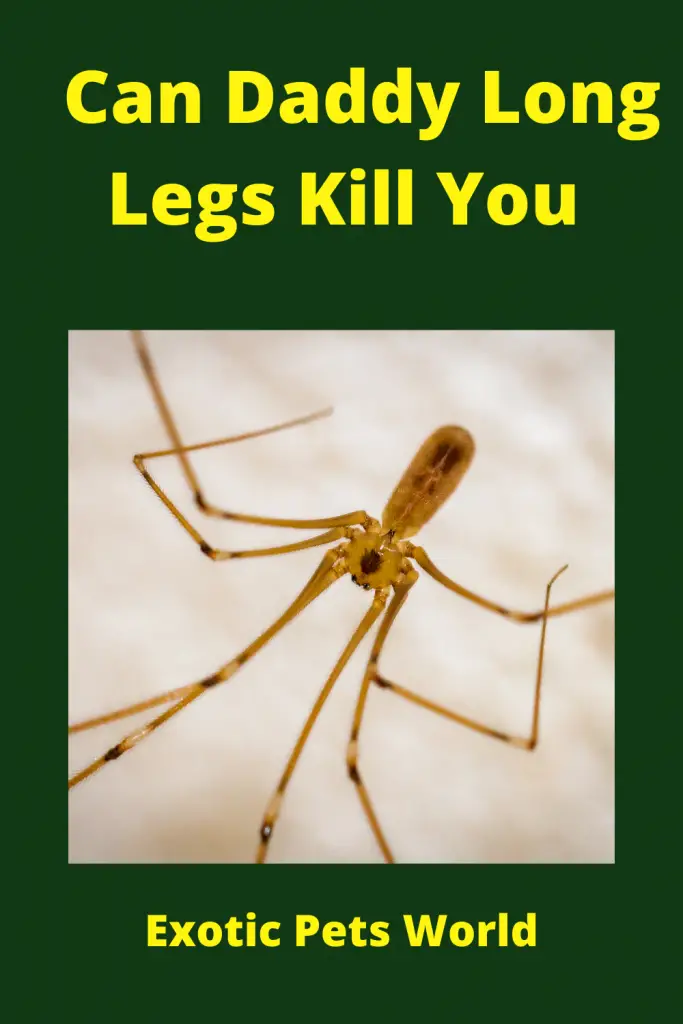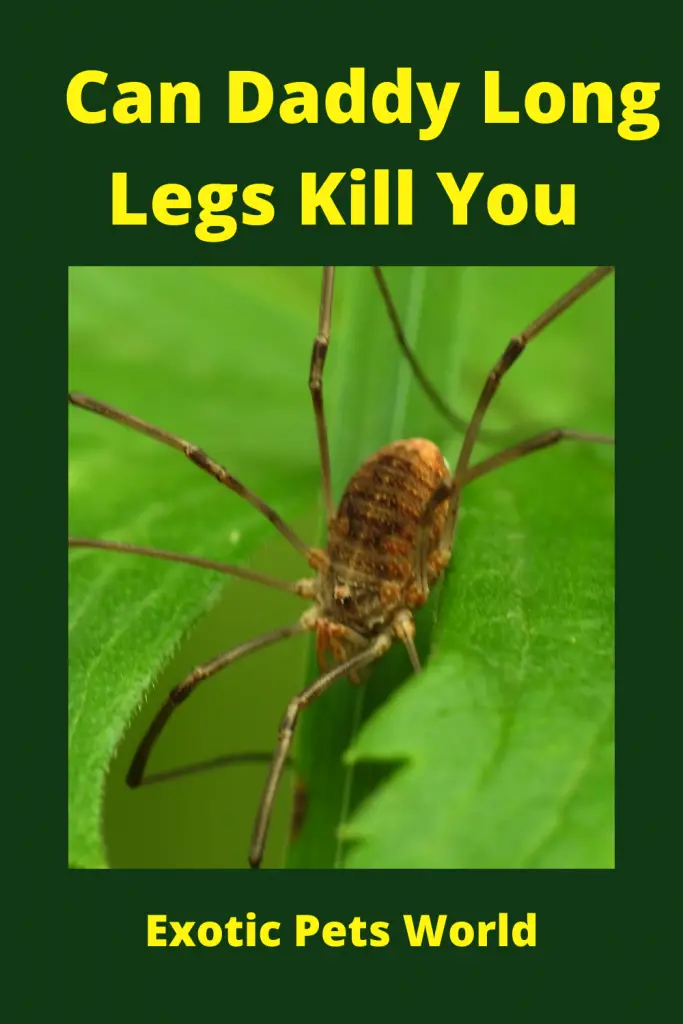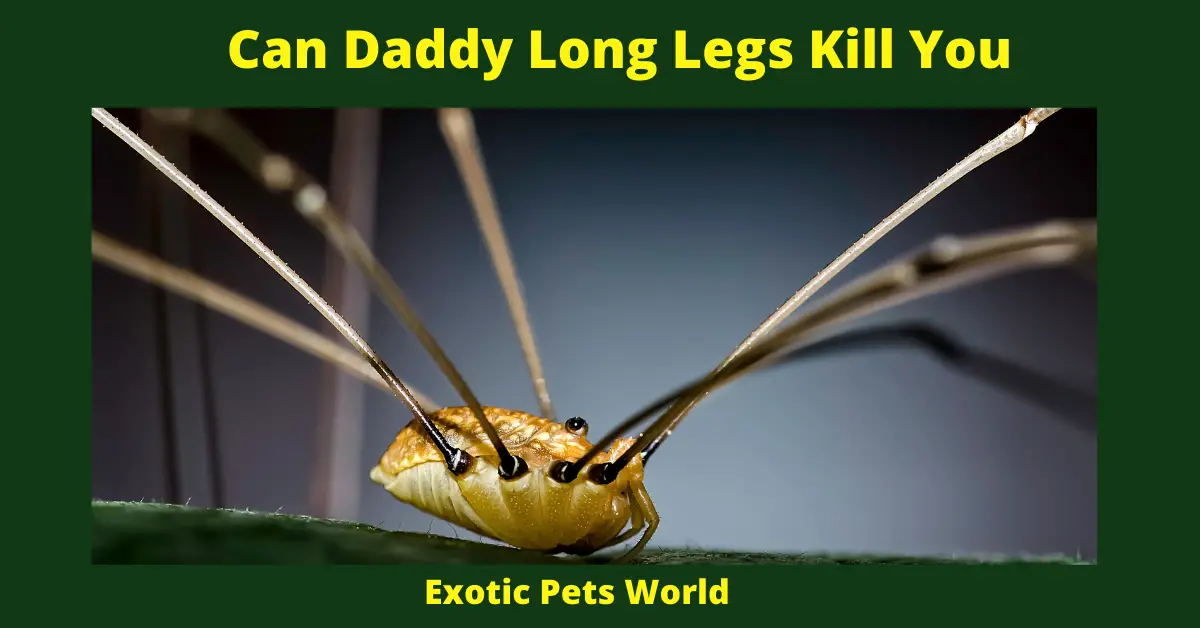Can Daddy Long Legs Kill You / Dangerous
Can Daddy Long Legs Kill You – Daddy long-leg spiders are not spiders at all – they are arachnids. Daddy longlegs spiders do not bite or attack people. They also have two main characteristics that set them apart from other spiders: their size and the way they walk or run on eight hairy feet instead of three.
Daddy long-leg spiders can be found in dark corners of your home like basements and closets, but they pose no threat to humans. They are not harmful spiders so don’t worry! So the answer to “Are daddy long legs spiders dangerous?” is NO! Daddy longlegs spiders do not bite or attack people. That being said, spiders, in general, can cause long-term effects, such as arachnophobia.
Arachnids are members of the class Arachnida, which also contains spiders and ticks. They’re found all over Earth’s surface: in soil or water; on trees or buildings or walls; even deep underground. There are more than 40,000 different types of arachnids!
Daddy long legs are harmless to other arachnids. They can prey on spiders, ticks, and scorpions!
Can you Die from a Daddy-Long Leg Bite?
A daddy long leg’s bite is not harmful to humans. The spiders are usually too small to break the skin, and their fangs (they actually have no Fangs)cannot penetrate human flesh. This means that a daddy-long leg will most likely release its venom on your hand if you try to take it off of your face or out of your hair by grabbing it with your hand.
– If you are bitten by a daddy-long leg, the spiders may release more venom into your skin to deter predators that attempt to eat them, and this can be irritating for humans as well.
– But don’t worry! Daddy Long Legs spiders do not have enough potent venom in their fangs to actually cause any major damage to humans.
– So, what should you do if one spider crawls up your arm and bites you?
– You can brush it off with a dry towel or paper towel, then wash the area where they bit you with soap and water without scrubbing. This will remove any bacteria from the spiders’ fangs that could cause infection.
Should you Kill Daddy Long Legs?
– Daddy longlegs spiders are harmless and nocturnal
– They don’t bite humans.
– Their fangs are too short for the venom to penetrate human skin.
– You should kill daddy’s long legs spiders only if you find them in your home or yard.
– If you find them outside, they’ll likely leave when it’s dark.
– The spiders have an important role in the ecosystem by eating other pests such as mosquitoes and flies. Killing daddy-long legs will cause these populations to rise exponentially!
Are Daddy Long Legs the most Poisonous Spider in the World?
Daddy longlegs spiders are not spiders; they’re a type of arachnid. They don’t have fangs, so you can’t get bitten by them and it’s impossible for the venom to be injected into your skin. Spiders use their bite to inject venom from glands found in the spider’s head (the cephalothorax) into the prey.
– Daddy longlegs spiders are not aggressive and they usually only bite if you crush them or get too close to their webs. They don’t carry venom as a bee would, but it’s possible that irritants in daddy long legs spiders’ mouthparts may cause your skin to itch for weeks after being bitten.
– Though spiders are the most venomous animals out there, daddy longlegs spiders are unable to inject enough of a dose for humans.
– Even if you were bitten by one and it was able to inject some amount of irritant into your skin, they’re not poisonous spiders so there’s no risk that anything bad will happen. Daddy longlegs spiders are harmless to humans.

Do Daddy-Long-Legs Hunt Spiders?
– Daddy Long Legs do not hunt spiders. They only eat spiders that are already dead or dying, so they cannot be considered a threat to spiders in the wild because daddy’s long legs don’t have any way of catching them.
– The two species of spiders which daddy long legs prey on most frequently are black widows and brown recluses.
– Daddy longlegs spiders are able to catch spiders which they prey on because daddy long leg spiders have a much longer body than any other spider, and so their bodies can be used as an extension of the web in order to capture prey closer to the ground. A daddy-long legs’ silk is designed for capturing live spiders rather than for capturing prey that is already dead.
Do Daddy-Long-Legs Kill Black Widows?
Daddy Long Legs actually do not kill spiders. They do not eat spiders, nor are spiders their typical prey. Daddy Long Legs will kill spiders if they encounter them in the process of catching other insects to feed on instead.
Daddy-long-leg spiders hunt for food by waiting near a web and grabbing any insect that falls into it while avoiding the spider itself. This is where spiders can be a danger to Daddy Long Legs spiders. If their prey is caught by the spider, it’s game over for anyone waiting around in that web.
Daddy-long-legs spiders will also drink water droplets from plants and live on webs spun together with silk of other spiders, which they take care not to damage or consume themselves.
Daddy Long Legs will consume dead highly venomous spiders that have died – That is where they get the reputation of Being Highly venomous and aggressive, which they are neither.
What do Daddy Long Legs Eat in the House?
Daddy Long Legs is an insect that can be found around houses. A common misconception about daddy long leg is that it’s dangerous to humans and needs to be killed on sight by spraying with a high-pressure hose or spraying them down with bug spray. This couldn’t be further from the truth! Read below to find out what daddy long leg is and how it behaves.
Daddy Long Legs are the most common arachnid in houses in North America with an average of 800 daddy long legs per house. They have a brown or black body, large size (reaching up to 20 centimeters), has four pairs of hairy antennae, and eight long legs.
The daddy long leg does not make webs but feeds on houseplants, dead insects or spiders, and other arthropods in the home.
Daddy Long Legs move around at night to look for food by climbing up walls like a spider would do with their sticky feet which anchor them into place as they walk upside down. They only eat dead insects or spiders, and daddy longlegs are not a danger to humans.
The daddy-long leg is also the official state insect of Massachusetts which was designated in 1932 after they were found all over Boston’s Beacon Hill Park.
There you have it! If daddy long legs are near your house make sure to leave them alone. They are not a danger to humans and daddy long legs food is houseplants, dead insects or spiders, and other arthropods in the home.

How Do you make a Daddy Long Legs Habitat?
If you’re looking to make Daddy Long Legs a pet, you can do so by providing the spider with an environment that mimics its natural habitat.
– Daddy long legs enjoy living in dark and damp places like under leafy shrubs or logs which are often found on ground level. You will need a container big enough for Daddy Long Legs to build webs, and Daddy Long Legs live inside these webs most of the time.
– Daddy long legs eat many insects, so it’s important to feed Daddy Long Legs a diet heavy with protein like mealworms or roaches. You can also provide Daddy Long Legs with fresh fruit from time to time; however, avoid giving them items that have been sprayed with pesticides.
– Daddy long legs are also nocturnal, so they will likely be most active during the evening hours when it’s dark outside. Daddy Long Legs can’t survive in a lit environment and would dry out if left exposed to sunlight for too long.
– Fresh fruit and mealworms (or other insects) for Daddy Long Legs to eat
. Daddy Long Legs can also eat bananas, apples, oranges, and grapes.
Where did Daddy Long Legs come From?
Long Legs are part of the Daddy longlegs family. Daddy Long Leg spiders, also known as cellar spiders or woodlouse hunters, have eight legs and vary in color from light to dark brown with black spots on their bodies. Daddy long leg spiders typically live outside near grassy areas where they make webs to catch prey such as flies and other insects. Daddy Long Legs are not a danger to humans, but they can bite if provoked or frightened.
Daddy longlegs spiders have eight legs and vary in color from light to dark brown with black spots on their body. Daddy long-leg spiders typically live outside near grassy areas where they make webs to catch prey such as flies and other insects. Daddy longlegs spiders are not a danger to humans, but they can bite if provoked or frightened.
How Many Species are there?
There are about 100 Daddy Long Legs species. This is because Daddy Long Legs spiders don’t stick to one single type of environment, but range from grasslands and forests all the way to urban settings around human dwellings. They’re found throughout Europe, in North America, and other parts of Asia like South Korea, Japan, China, or Taiwan. Daddy Long Legs spiders are so diverse that scientists have managed to identify Daddy Longlegs subspecies, such as the Daddy-long-legged spider (Tibellus oblongus) in North America.
There is a wide variety of Daddy Long Leg species out there and they range from small to giant. The largest Daddy long legs species are the Daddy-long-legged spider (Tibellus oblongus) and Daddy Longlegs
(Pholcus phalangioides). The Daddy long legs spider is about two inches in length, but some Daddy Long Legs spiders can be as small as a few millimeters. When you compare them to other common spiders, Daddy Long Legs spiders are tiny.

Do Daddy Long Legs Live in Trees?
Long Legs live on fences, walls, and plants. Daddy long legs are not a danger to humans because it does not bite or sting people. Daddy Long Leg will also eat other insects like flies and mosquitoes so they are useful for gardens in the summertime.
– Daddy longlegs have very strong jaws that can grip their prey without causing any harm
– Daddy longlegs can use their jaws to break through the exterior of an egg and eat the small insects inside. They will also suck liquids out of plants with their straw-like mouthparts
Daddy Long Legs Life Cycle?
The lifecycle of the daddy long legs arachnids. Daddy Long Legs are not insects. Daddy long legs go through the following life cycle: egg, nymph/juvenile stage, an adult stage which is sometimes called a ‘senior citizen’.
Daddy long legs live in moist or humid places like your garden shed and dark corners of bookshelves because they prefer to be hidden from predators. They’re most active at night and Daddy Long Legs eat other insects.
Lifespan
Their average lifespan is one year.
Daddy Long Legs have a soft body with eight legs and two long thin appendages called “pedipalps” at the front of their face which they use to feel out what’s around them, like an elephant’s trunk. Daddy Long Legs are not venomous but do have small mouthparts that can suck up liquids such as water and they also have a short and stubby tail at the end of their abdomen.
Daddy Long Legs can grow up to six inches in length but are more often about two or three inches long.
Daddy long legs come from many different species such as Daddy Long Leg tarantulas and Daddy Long Legs scorpions. Daddy Long Legs spiders are not Daddy Long Leg scorpions. Daddy long legs are not as dangerous to humans as some other spiders because Daddy Long Legs typically do not have venom that can harm people and Daddy Long Legs rarely if ever bite a person, but it is possible for the Daddy Long Legs’ pedipalps to scratch human skin.
Daddy long leg tarantulas will often eat Daddy Long Legs scorpions. Daddy long legs do not have a waxy coat like other spiders – they are more like an insect and Daddy Long Legs shed their skins to grow bigger.
Daddy long legs can run up walls as well as across the ground which means that humans can be in contact with them without even realizing it. Daddy long leg habitats are usually around garden sheds, dark corners of bookshelves, and damp or humid places. Daddy long legs prefer to be hidden from predators rather than being seen and Daddy Long Legs eat other insects which is why they’re most active at night.
If a Daddy Long Leg loses a leg in trying to escape a predator, they cannot like their cousins the spiders, regrow the lost leg.
Do Daddy-Long-Legs Kill Redback Spiders?
– Daddy long legs are not known to kill redbacks, but they will eat their eggs if given the chance. They have been seen eating poisonous spiders, Brown Recluse, Black Widows, and Redbacks but more than likely these spiders were already dead and the daddy longlegs is making the most of a good opportunity.

Final Thoughts
Daddy long legs are not as dangerous to humans as some other spiders, and Daddy Long Legs prefer dark corners of bookshelves or garden sheds. Daddy long leg habitats can be around your garden shed, a dark corner in the kitchen, or any area with high humidity levels because Daddy Long Legsprefer being hidden from predators rather than being seen.


Good post. I study one thing more difficult on totally different blogs everyday. It would all the time be stimulating to learn content material from other writers and follow somewhat one thing from their store. I抎 desire to use some with the content on my blog whether you don抰 mind. Natually I抣l give you a link on your internet blog. Thanks for sharing.
I’m curious to find out what blog platform you have been utilizing? I’m experiencing some minor security issues with my latest blog and I’d like to find something more secure. Do you have any recommendations?
I’m really impressed with your writing skills as well as with the layout on your weblog. Is this a paid theme or did you modify it yourself? Either way keep up the excellent quality writing, it抯 rare to see a great blog like this one nowadays..
I just like the helpful info you supply in your articles. I抣l bookmark your blog and check again right here regularly. I am rather certain I抣l learn a lot of new stuff right here! Best of luck for the next!
ろり ラブドール バイヤーズガイド:ダッチワイフを購入する前の興味深いポイント